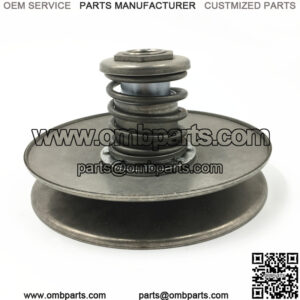Basic Functions of a Snowmobile Clutch
A snowmobile clutch’s basic function is to transfer the power generated from the engine to the shafts that help propel the machine forward. You can think of a clutch as a bridge that harnesses horsepower into motion that a snowmobile can use.
The clutch system on any snowmobile is also known as a continuously variable transmission or CVT. This type of system has been around for hundreds of years and is a fundamental mechanical aspect of a modern engine.
A snowmobile CVT is different than an automatic transmission in your car. The car will have a set amount of gears, while the CVT allows for the snowmobile to have an unlimited amount of gears for smooth increases and decreases of speed.
How a Snowmobile Clutch Works
A snowmobile clutch consists of two different pulleys. Each of these pulleys is a clutch, and a belt connects them. A snowmobile has a primary clutch and a secondary clutch. They work together to transfer power.
When you start up the engine, the crankshaft engages the primary clutch. The primary clutch is made up of two different parts – the stationary sheave and the movable sheave.
As the engine starts and functioning at lower RPMs, these two sheaves are separated by a pressure spring. When you hit the throttle and the RPMs increase, enough force is generated to bring the two sheaves closer together.
At this point, the clutch engages, and the belt connecting the two pulleys (clutches) begins to spin. This brings power to the secondary clutch, which is connected to the jackshaft.
The jackshaft brings power to the chaincase, which turns the track on your snowmobile and propels it forward.
The two clutches allow the stepless transmission to be smooth and won’t ever really feel a shift of gears when you are riding. When you reach top speeds, the primary clutch will close, allowing the belt to spin as fast as the RPMs.
This video demonstrates the two clutches in action on a CVT and can help you get a better picture of everything I just described.
Components of a Snowmobile Clutch
Here’s a quick breakdown of a snowmobile clutch’s various components to help you get a better idea of how everything works together to power the sled.
Primary Clutch: Connected to the engine crankshaft and the first point of motion for a CVT transmission. This clutch closes at higher RPMs, allowing for smooth power transfer.
Secondary Clutch: Connected to the primary clutch by a belt. Once engaged, this clutch begins to turn the jackshaft which is connected to the chaincase.
Clutch Weights: These are weights that help increase the force of the crankshaft and drive up RPMs. Once enough force is generated, it separates the two sheaves and engages the clutch.
Clutch Sheaves: These are parts of the primary clutch and consist of a moveable sheave and a stationary sheave. As RPMs increase, the two sheaves move toward one another and engage the belt between the primary and secondary clutch.
Clutch Spring: A spring that allows for smooth engagement of each clutch.
Helix: Part of the primary clutch that separates the two sheaves. Different helix angles allow for faster clutch engagement.
Cleaning the Clutch
If you are experiencing issues with your snowmobile’s performance, you might need to clean your clutch. I’ll explain this in detail in another dedicated post to the subject, but I wanted to mention it here.
If you notice poor acceleration or jumpy performance when you are on the throttle, you may need to clean or even replace the clutch. The cleaning process involves removing the clutches with pullers and then washing each component.
If you aren’t experienced with basic mechanics, you should have a shop perform this task, but it’s not that difficult if you have the right tools and some basic knowledge. Some people use warm water to clean, but I like to use brake cleaner for deeper clutch cleaning.

